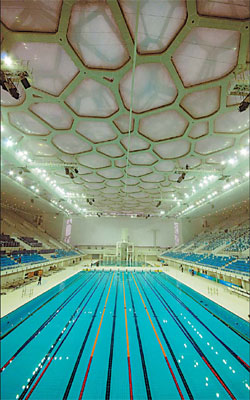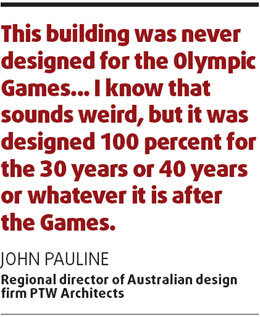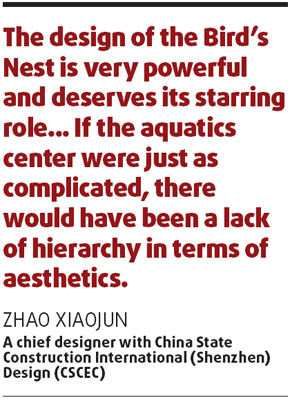
More Photos

This bubble is not bursting any time soon
Beyond its already legendary "bubble wrap" lies a hidden world that will open to the public for the Swimming China Open, a tune-up for the Beijing Olympic Games, from January 31 to February 5.
 This is what the National Aquatics Center, or Water Cube, looks from inside. [China Daily]
This is what the National Aquatics Center, or Water Cube, looks from inside. [China Daily] |
"People often comment on the bubble effect of the outer membrane, but we're hoping the things inside will really make jaws drop," says John Pauline, regional director of Australian design firm PTW Architects.
"Whenever I've taken visitors inside, normally there's a moment of silence. Basically we've continued the aesthetics outside and inside, except that the bubbles inside are not blue. We deliberately made them neutral, more transparent and white. It's what we call a holistic design, so you get this wonderful sense of being in a bubble bath looking up."
PTW teamed up with compatriot Ove Arup and China State Construction International (Shenzhen) Design (CSCEC) to create the National Aquatics Center after winning the bid in early 2003. Construction started in December that year. It is based on a geometric cell made up of 12 pentagons and two hexagons, and built using a Vierendeel space frame, or a series of interlocking rectangular frames.
An outer membrane of translucent bubbles, or ethylene-tetrafluoroethylene (ETFE) pillows, has been sown in place to give its 175-m-long, 35-m-high structure an elastic "skin" and futuristic feel.
"The Water Cube and Bird's Nest (the National Stadium) are not only sports venues, they are works of art," CSCEC's Zhao Xiaojun told state broadcaster CCTV earlier this month. "We think they are going to attract large numbers of visitors."
The two venues will form the centerpiece of the August 8-24 Olympic Games. The Water Cube is already the world's largest single ETFE structure (100,000 sq m of the material was used). Though it may look like a giant bubble, the building's outer skin can withstand the weight of a car and even stretch to three or four times its size.
 In terms of ramping up the wow factor, however, a science fiction-like watering hole that goes by the working name of "Bubble Bar" will be hard to beat. "The coolest thing inside is the bubble bar," says Pauline. "We wanted just one space inside to be absolutely driven by the structural nature of the building, to be very organic, and really make it feel as if you're sitting within a bubble.
In terms of ramping up the wow factor, however, a science fiction-like watering hole that goes by the working name of "Bubble Bar" will be hard to beat. "The coolest thing inside is the bubble bar," says Pauline. "We wanted just one space inside to be absolutely driven by the structural nature of the building, to be very organic, and really make it feel as if you're sitting within a bubble.
"A spiral staircase will take you up from the entrance to the suspended bar that sits below the bubbles. You'll be sitting immersed in and surrounded by all the bubbles, which will be lit from the inside. And so, from an architectural perspective, even though it's small, it's going to have an enormous punch."
Though athletes and sports officials in need of a nightcap will be the first to have dibs on it during the Games, the bar is likely to go commercial later. This is part of broader efforts to ensure the Water Cube turns into a long-term profit-making venture rather than sink into the annals of history as another money-losing white elephant - as has been the case at previous Olympics and soccer World Cups. Centro and Suzie Wong's beware.
"This building was never designed for the Olympic Games," says Pauline. "I know that sounds weird, but it was designed 100 percent for the 30 years or 40 years or whatever it is after the Games."

Armed with an agenda of multi-space functionality, the designers will tear out two-thirds of its 17,000 seats after the Games to create space for other projects. The venue already includes two tennis courts and has space for retail outlets, office space, nightclubs, restaurants and more.
"That's when we go into a whole next level of design, rip out all the seats, change its internal face and environment. When we came to Beijing, we proposed something that was very unusual by dedicating about one-third of the building to an indoor leisure center to ensure it had a heart and soul for the capital's residents in the future," he says.
The water slides and leisure center that PTW introduced to the swimming venue for the Sydney Games in 2000 have proved wildly successful, hence the decision to replicate them in Beijing. But the venue had drawbacks. "Sydney was too enclosed and not transparent," says Pauline. The seating was all wrong. Having the major part of the viewing gallery on one side of the pool created a sense of acoustic imbalance that could have distracted swimmers. This summer, spectators will cheer from both sides for a more symmetrical effect.